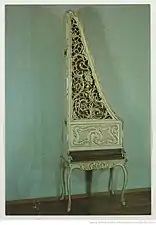Albert Delin
Albert Delin (17 April 1712, Ath – 26 November 1771, Tournai;[1] also known as Albertus Delin) was a harpsichord maker in the Low Countries.

Biography
Born in Ath in Southern Netherlands (now in Belgium), he soon moved to the nearby town of Tournai to practice his trade. Little is known of his training but a remarkable number of his instruments have survived. His building style is quite contrary to his more famous contemporaries, like his neighbours Dulckens in Antwerp, the Hass family in Hamburg or the Taskins of Paris, that at the time created complex machines with an extensive variety of registers and knee levers. Delin's surviving instruments are simple, reminiscent of the old Ruckers instruments of a century before and of good workmanship as witnessed by the number of surviving instruments.
Surviving instruments
- Two surviving harpsichords (1750 and 1768), both have a single manual and have only two 8' choirs and a buff stop, with all battens protruding through the instruments side, similar to original Ruckers instruments.
- Kottick mentions four bentside spinets (1763, 1765, 1766, 1770),[2] all with a single 8' choir. A colorful fifth bentside spinet signed "A.D. 1738" and bearing a rose with the initials AD, has been attributed to him as well.[3]
- Three clavicytheria (1751, 1752, 1760), strung like his harpsichords with two 8' registers, and guidebattens protruding through the cheek. The clavicytheria have an elegant pivot mechanism of Delins' own design, needing no spring action and only gravity for the return.[4] Chung describes Delins clavicytherium thus: "[he] succeeded in overcoming the difficulties of building an upright harpsichord better than any other builder. His three instruments, which are considered by many to be the finest of all surviving clavicytheria, have an amazingly fine touch that is achieved by a special action that upon the release of the keys allows the jacks to return without the need of springs or additional weights."[5]
- The last surviving instrument is even more old fashioned than the rest, a small, hexagonal, octave spinet (1750).
Decor of the instruments
Delin's original case decor seems to have been simple, but some of his instruments later received "makeovers". Most notably his 1760 clavicytherium, was retrofitted with an extravagant gilded, rococo door.[6] The 1738 spinet is elaborately painted with a forest scene on the inside of the lid, while the case is covered with a menagerie of monkeys playing musical instruments.[7]
The soundboard paintings in Delin's instruments are typical Flemish floral motifs, with visible outlines, flat coloring and little detail, a style similar to the Ruckers.[8]
Bibliography
J. Tournay, "À propos d’Albertus Delin (1712-1771). Petite contribution à l'histoire du clavecin", in La facture de clavecin du XVe au XVIIIe siècle, Louvain-la-Neuve, 1976, pp. 139–232.
J. Tournay, "The Double Orientation in Harpsichord Building in the Low Countries in the Eighteenth Century", in The Harpsichord and its Repertoire, Utrecht, 1990, pp. 21–45.
Image gallery
 The 1750 harpsichord in the musical instrument museum in Berlin
The 1750 harpsichord in the musical instrument museum in Berlin_by_Albert_Delin_-_MIM_Brussels_(2015-05-30_07.26.30_by_chibicode).jpg.webp) The 1751 clavicytherium in the musical instrument museum in Brussels
The 1751 clavicytherium in the musical instrument museum in Brussels The 1752 clavicytherium at the musical instrument museum in Berlin
The 1752 clavicytherium at the musical instrument museum in Berlin The 1760 clavicytherium in Gemeentemuseum in the Hague
The 1760 clavicytherium in Gemeentemuseum in the Hague The 1765 bentside spinett in the musical instrument museum in Berlin
The 1765 bentside spinett in the musical instrument museum in Berlin
See also
References
- Grove Music Online, Published online January 2001
- Kottick EL, A History of the Harpsichord,2003, Indiana University Press, pp. 291–292
- The website of the musical instrument museum in Paris, Musée de la Musique
- Kottick EL, A History of the Harpsichord,2003, Indiana University Press, p294
- Chung, David. 2005. Review of Jean-Henry D’Anglebert: Pièces de clavecin (Paris, 1689). Hank Knox, clavicytherium. Les Productions Early-music.com, 2003. Journal of Seventeenth-Century Music 11.1.
- Kottick EL, A History of the Harpsichord, 2003, Indiana University Press, p295
- The website of the musical instrument museum in Paris, Musée de la Musique
- Kottick EL, A History of the Harpsichord,2003, Indiana University Press, p293
Sources
- A History of the Harpsichord, Kottick EL, 2003, Indiana University Press, pp. 290–296
External links
- Detailed photos of the colorful 1738 spinet preserved at the musical instrument museum in Paris, Cité de la Musique